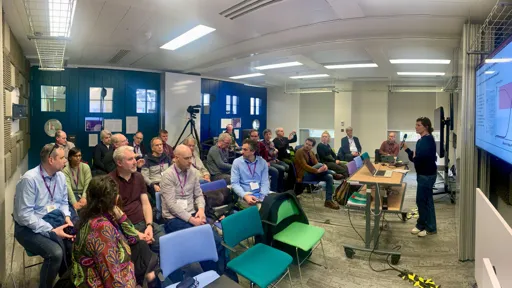
Werner Bleisteiner, Creative Technologist, BR; Co-chair, EBU Audio Systems group
More and more, broadcast technology topics break traditional silos. Take speech intelligibility (SI), tackled from various angles by five EBU groups: Audio Systems (AS), Personalized Sound Experiences (PSE), Media Access Technology (MAT), Quality Control (QC), and Access Services Experts (ASE). All five met recently for a joint transversal workshop at BBC R&D, London.
“Why broadcast speech intelligibility matters”. A ‘title as statement’ from RNID* Technology Lead Lauren Ward kicked off the workshop: some 20% of people in all countries are affected by hearing loss. And it’s not just anecdotal evidence but also media intelligence telling us that subtitles are left constantly switched on. So, what’s wrong with the audio?
Undoubtedly, since the introduction of digital production technology, audio mixes have become complex: there’s more music, more foleys, lots of effects, and more ‘naturalism‘ in speech, whereby directors want mumbling rather than stage-like pronunciation. That might be fine as artistic intent, but where should the line be drawn? And what can be done so that all in the audience can understand and enjoy what’s being said?
The first day featured four blocks, with top experts to provide input:
- Research – Trevor Cox (University of Salford) introduced the UK’s Clarity Project, applying AI to simulate and predict hearing and hearing-aid processing, while Hannah Baumgartner (Fraunhofer IDMT) demonstrated ways to measure SI, now to be applied in audio production tools.
- Requirements – Cathy Taylor (Ofcom) presented the UK regulator’s view (significantly, SI had already been on the UK parliament’s agenda). Kieran Lynch (IADT) provided the background to an EBU report on audio description dip levels (TR 084). Max Kiefer (WDR) explained ARD’s Klare Sprache (clear speech), a 24/7 additional audio stream for DVB broadcasting. Thomas Lund (Genelec), well known for his profound contributions to EBU R 128, enlightened us on the relationship between auditory perception and loudness.
- Broadcast workflows – renowned sound engineer Tony Churnside (BBC) demoed stunning acoustical illusions. Focusing on audio description, Philip Klenk (SWR) and Nigel Megitt (BBC), co-chairs of the EBU MAT group, explained the differences in workflow and technologies applied for "broadcast mix" and "receiver mix". Alan Archer-Boyd and Lawrence Pardoe recapped BBC R&D’s manifold work on dialogue enhancement.
- Object-based audio – BBC’s Dave Marston (PSE chair), as a major figure behind ADM (the widely adopted metadata scheme, standardized by the ITU), gave a crash course. Jacob Smith (Dolby) and Daniela Rieger (Fraunhofer IIS) explained how ADM and S-ADM have become essential for producing adaptive and personalized audio experiences for AC-4 and MPEG-H. Scott Kramer and Iroro Orife outlined how they drive SI a tick further at Netflix. Finally, Andrew Dunne (BBC), as chair of the EBU QC group, discussed aspects for quality control.
On day two, three groups – SI, AD, QC – of each five to seven people, elaborated approaches for solutions, touring the demo stations and questioning the experts. To wrap it all up, there was a one-hour open discussion.
The common basic finding was that an object-based production approach with ADM – with speech elements kept separate from ambience, music and fx – is the ideal approach to tackle any downstream requirements and flexibly deliver better SI and AD. There is an urge to move forward in production practice, which needs to be reinforced through deliverable specifications.
To wrap up, members of the five EBU groups gathered to recap and brainstorm with fresh memories about takeaways and joint actions. Quite a few bullet points…
*The national hearing loss charity in the UK
This article first appeared in the June 2025 issue of tech-i magazine.
